 Vision, Strategy, and Tactics Vision, Strategy, and Tactics
By Terri Fassio
April, 2007
Vision: How you envision your Grange in the community; your dream.
Strategy: What you are going to do to achieve your vision.
Tactics: How you will achieve your strategy and when.
Vision is your members dreams of what the Grange strives to be within your community. Strategy is the large-scale plan your Grange will follow to make that dream happen. Tactics are the specific actions your members will take to follow the plan. Start with the vision and work down to the tactics as you plan for the future of your Grange.
Concepts Are The Same
Whether you are planning for the next month or the next five years, the concepts are the same. Only the scale is different. You start with the vision statement (sometimes called a mission statement). When you know what the vision is, you can develop a strategy to get you to the vision. When you have decided on a strategy, you can then develop tactics to meet the strategy.
Vision
A vision is an idea -- what the Grange should be, and how it will fit into it's surroundings (community). Often the vision reflects the combined dreams of the members, as well as following the path set forth by the founders of the organization. Your Grange's vision could be, for example, to be "an organization that helps the underprivileged in the community," "the voice of community concerns and liaison to the State Government," or "setting an example for other non-profit organizations in the community." A vision must be sufficiently clear and concise that everyone in the organization understands it and can buy into it with passion.
Strategy
Your strategy is one or more plans that you will use to achieve your vision. To be "the voice of community concerns and liaison to the State Government" you might have to decide whether it is a better strategy for you to hold town forums and meetings at your Grange Hall, try to canvas the community for their thoughts and opinions, or a combination of both. A strategy looks inward at the organization, but it also looks outward at the environment and community climate.
To be "setting an example for other non-profit organizations in the community" your strategy would need to evaluate what other organizations offer in community services, which of those target your audience, and which organizations could in the future benefit from the Grange's services. Your strategy also must determine how you will become "the organization of choice." What can your members do so that your targeted audience chooses your Grange? Are you going to offer the most benefits to the community? Will you participate in community events, such as the local parade or fair/festival? Will you recruit the very best people and build a reputation for delivering the most innovative solutions? What makes your Grange stand out?
If you decide to make a statement in your community, what will you do to attract new members, and then encourage them to participate once they join? If you decide to recruit the best new people, how will you enlighten them, and retain them? Your strategy must consider all these issues and more to find a solution that works AND that is true to your vision.
Develop Flexible Tactics
Tactics
Your tactics are the specific actions, sequences of actions, and schedules you will use to fulfill your strategy. If you have more than one strategy you will have different tactics for each. A strategy such as "to be a well-known local organization," as part of your vision to be "setting an example for other non-profit organizations in the Community" might involve tactics like advertising in the Non-Profits Quarterly Newsletter for three successive issues, placing brochures in the town tourism center, advertising in the largest-circulation newspaper in the area for the next six months, hanging posters at the local grocery store, having a booth at the "Taste of the Town" festival, having a float in the Memorial Day Parade, or even buying TV time on the popular TV station or radio station in the area to promote your community services. It could even be as simple as a bake sale at the local supermarket. Or it could involve sending a letter of introduction and a brochure to the Executive Director of every non-profit organization, chamber of commerce, and giving foundation in the area.
Firm or Flexible?
Things change. Your Grange needs to change with them, or if possible, ahead of them. However, with respect to vision, strategy and tactics, you need some flexibility and some firmness. Hold to your Grange's dream/vision. Don't let that be buffeted by the winds of change. Your vision should be the anchor that holds all the rest together. Strategy is a longer-term plan, so it may need to change in response to internal or external changes, but strategy changes should only happen with considerable thought. Changes to strategy also should not happen until your Grange has a new one to replace the old one. Tactics are the most flexible. If some tactic isn't working, adjust it and try again.
Manage This Issue
Whether for one department or the entire Grange, vision, strategy, and tactics are essential. Develop the vision first and hold to it. Develop a strategy to achieve your vision and change it as you have to, to meet internal or external changes. Develop flexible tactics that can move your Grange towards fulfilling your strategy and ultimately vision. |
